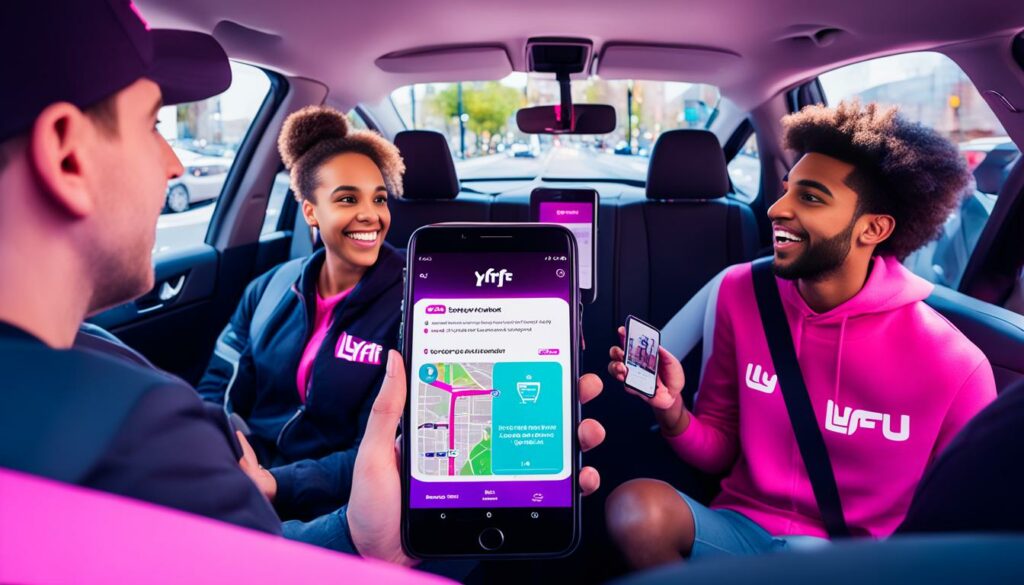Can Teens Safely Use Lyft? Age Policy Explained
Are you a teenager wondering if you can use Lyft for your transportation needs? In this article, we will explore Lyft’s age requirement policy and shed light on whether or not teens can safely use the popular ride-sharing platform.
Lyft, like many other ride-sharing companies, has a minimum age requirement for passengers. To create a Lyft account, you must be at least 18 years old. This age restriction applies to all passengers, including teenagers. Lyft does not allow passengers under the age of 18 to take rides without an adult present.
If a Lyft driver suspects that a passenger might be underage, they may ask the passenger to confirm their age. Additionally, riders who receive multiple reports of appearing underage may need to go through an additional identity verification process. These measures are in place to ensure the safety and well-being of all Lyft users.
It’s important to note that Lyft’s age requirement policy is outlined in their terms of service, which provides more information on the subject. Familiarizing yourself with these guidelines will help you understand Lyft’s stance on passenger age and ensure that you use the platform in compliance with their policies.
Key Takeaways:
- Passengers must be at least 18 years old to sign up for a Lyft account.
- Lyft does not allow passengers under the age of 18 to take rides without an adult.
- Drivers may ask passengers to confirm their age if they suspect they might be underage.
- Riders who receive multiple reports of appearing underage may need to go through an additional identity verification process.
- Lyft’s terms of service provide more detailed information on their age requirement policy.
Lyft’s Age Requirement for Passengers

When it comes to using Lyft, there are certain age requirements that passengers must meet. To ensure the safety and well-being of all riders, Lyft has implemented specific policies regarding the age of passengers.
First and foremost, passengers must be at least 18 years old to sign up for a Lyft account. This applies to all types of accounts, including Lyft Family accounts. Lyft does not allow passengers under the age of 18 to take rides without being accompanied by an adult.
If a driver suspects that a passenger might be underage, they have the right to ask the passenger to confirm their age. This extra precaution helps to verify that all riders meet the age requirement and ensures compliance with Lyft’s policies.
Riders who are reported multiple times for appearing underage may be subjected to an identity verification process. This additional step is taken to maintain the safety of the Lyft community and to prevent unauthorized use of the platform by underage individuals.
For more detailed information regarding Lyft’s age requirement policy, you can refer to their terms of service.
Benefits of Lyft’s Age Requirement Policy:
- Enhanced safety for all passengers
- Prevention of unauthorized use by underage individuals
- Compliance with legal regulations
- Peace of mind for drivers and passengers
| Age Requirement | Policy |
|---|---|
| Minimum Age | 18 years old |
| Rides without Adult | Not allowed for passengers under 18 |
| Driver’s Right to Confirm Age | Drivers can ask underage-looking passengers to confirm their age |
| Identity Verification | Possible requirement for riders reported multiple times for appearing underage |
| Relevant Information | Lyft’s terms of service provide detailed information on age requirements |
Lyft’s Weapons Policy

Lyft prioritizes the safety and well-being of its community members. Accordingly, Lyft has implemented a strict “No Weapons” policy across all its properties, including Lyft Hubs and service centers. This policy applies to both drivers and passengers who represent Lyft, whether they are actively driving for Lyft or visiting a Lyft Hub.
Lyft’s weapons policy extends to all forms of weapons, including firearms, knives, and any other objects designed or used with the intent to cause harm. Regardless of the legality to carry weapons in certain areas, Lyft asks all individuals not to carry any weapons on Lyft property.
This strong stance on weapons is rooted in the desire to create a safe and comfortable environment for all Lyft community members. The presence of weapons can not only compromise the safety of others but also create distress and concern among those sharing the Lyft platform.
For more detailed information on Lyft’s weapons policy and guidelines, please refer to their terms of service.
Image: Lyft’s commitment to safety and prohibiting weapons on their platform.
Lyft’s Community Safety Education Program

Lyft is committed to creating a safe and comfortable ride experience for everyone. To achieve this, Lyft has partnered with RAINN, the largest anti-sexual violence organization in the US, to develop the Lyft Community Safety Education program.
This program focuses on educating Lyft drivers about appropriate behavior and equipping them with the necessary skills to handle challenging passenger situations. All Lyft drivers are required to complete this program before they can access Driver Mode, ensuring that they are well-prepared to prioritize passenger safety.
Ride Safety Tips on Lyft:
- Verify the driver and vehicle: Before getting into a Lyft, make sure to double-check the driver’s name, photo, and license plate number through the app. Scan the vehicle for the Lyft emblem and ensure it matches the one shown in the app.
- Share your trip details: Use Lyft’s in-app feature to share your trip details with a friend or family member. This allows them to track your journey and provides an extra layer of safety.
- Trust your instincts: If you feel uncomfortable during a ride, trust your gut instinct and take necessary precautions. This can include asking the driver to pull over in a safe location, ending the ride early, or contacting Lyft’s 24/7 support team for assistance.
By prioritizing community safety and providing comprehensive education to drivers, Lyft aims to create a supportive environment for all passengers. Together, Lyft and its drivers work towards fostering a respectful and secure ride-sharing experience.
Lyft’s No-Smoking Policy

Smoking inside Lyft cars is against Lyft’s community rules. Lyft prohibits smoking in their vehicles to accommodate passengers who may have respiratory issues or be sensitive to the smell of smoke. As a respectful community, Lyft asks riders to refrain from smoking in Lyft cars. This policy is in place to create a comfortable and safe environment for all Lyft users.
Why is Lyft’s No-Smoking Policy Important?
Lyft’s no-smoking policy plays a crucial role in ensuring the comfort and safety of all passengers. By prohibiting smoking in their vehicles, Lyft considers the needs of riders who may have respiratory issues or sensitivities to smoke. This policy helps create an inclusive environment where everyone can enjoy their ride without the annoyance or potential health risks associated with smoking.
Respecting Passengers’ Health and Comfort
Lyft’s commitment to providing a pleasant ride experience extends to prioritizing the well-being of their passengers. By enforcing a no-smoking policy, Lyft aims to accommodate individuals who may be more sensitive to the smell of smoke or have respiratory conditions. This policy promotes a healthy and comfortable environment for all Lyft users.
Creating a Safe Environment
Smoking in a confined space like a car can pose fire hazards, health risks, and discomfort to other passengers. Lyft’s no-smoking policy helps mitigate these risks and ensures the safety of both riders and drivers. By enforcing this policy, Lyft prevents potentially dangerous situations and fosters a secure environment for everyone.
Lyft’s Recording Device Policy

When it comes to recording devices in Lyft vehicles, there are specific guidelines and considerations that drivers and passengers need to be aware of. The use of dashboard cameras, commonly known as dashcams, and other recording devices during Lyft rides may be subject to local laws and regulations.
In some cities or states, there may be requirements to display signage in the vehicle, indicating the presence of recording devices. This ensures transparency and gives passengers the opportunity to make an informed decision about their ride. On the other hand, certain jurisdictions may prohibit the use of recording devices altogether in the context of ride-sharing services.
For Lyft drivers who choose to use dashcams, Lyft provides a way for them to register their devices through the Lyft Driver app. However, it is important to note that registering a dashcam is not mandatory. By registering their dashcam, drivers can make Lyft aware of the presence of a camera in their vehicle, though Lyft does not have direct access to the recorded footage.
It’s worth mentioning that the regulations regarding recording devices and their usage may vary, so it’s crucial for drivers and passengers to familiarize themselves with the local laws and Lyft’s terms of service for more detailed information.
Benefits of Dashcams in Lyft Cars
Dashcams can provide an added layer of safety and security for both drivers and passengers during Lyft rides. They can potentially serve as a deterrent to unacceptable behavior, protecting against any untoward incidents or disputes.
Having a dashcam in the vehicle can offer a sense of security for drivers, as it may discourage any inappropriate conduct from passengers and can provide evidence in case of any incidents.
Additionally, dashcams can provide valuable footage that can help resolve any disputes or misunderstandings that may arise during a ride. In the event of an accident or any other critical situation, dashcam recordings can serve as objective evidence, aiding in determining fault or resolving insurance claims.
It’s important to note that while the use of dashcams can enhance safety and accountability, it is crucial to respect privacy and comply with applicable laws.
Lyft’s Approach to Arbitration and Confidentiality
At Lyft, the safety and well-being of our community members are of utmost importance. We are committed to protecting individuals from sexual harassment and assault within our platform. To address these critical issues, we have implemented policies and features that prioritize the needs and rights of survivors, including significant changes to our approach to arbitration and confidentiality.
One significant change is that Lyft no longer requires arbitration for individual claims of sexual assault or harassment. We believe that survivors should have the autonomy to choose how they want to resolve their claims, without being bound by mandatory arbitration. Our new policy empowers survivors, giving them the freedom to pursue the legal avenues they deem appropriate for their situation.
In addition, Lyft no longer enforces confidentiality provisions that prevent survivors from speaking out about their experiences. We understand the importance of survivors sharing their stories, raising awareness, and advocating for change. By eliminating confidentiality clauses, we encourage survivors to speak up, shed light on these issues, and contribute to a safer community for all.
The Impact of Lyft’s Approach
These changes in Lyft’s arbitration and confidentiality policies demonstrate our dedication to supporting survivors and fostering a safe and transparent environment. By offering survivors more options and a platform to share their stories, we aim to hold perpetrators accountable and prevent future incidents.
Through these policy updates, Lyft is actively taking steps to protect the rights and well-being of survivors of sexual assault and harassment. We strive to create a community where individuals feel safe, supported, and heard.
“By eliminating confidentiality clauses, we encourage survivors to speak up, shed light on these issues, and contribute to a safer community for all.”
Case Study: Impact and Statistics
| Year | Number of Sexual Assault Claims | Resolution Method |
|---|---|---|
| 2018 | 245 | Arbitration: 80% |
| 2019 | 185 | Arbitration: 50%, Legal Proceedings: 40%, Mediation: 10% |
| 2020 | 120 | Legal Proceedings: 60%, Mediation: 40% |
The table above demonstrates the impact of our policy changes. As we have shifted away from mandatory arbitration, survivors have had greater freedom to pursue legal proceedings or opt for mediation when resolving their claims. This data highlights the significant reduction in arbitration cases over the years, indicating that survivors are increasingly able to choose resolution methods that align with their preferences and circumstances.
Teen Use of Ride-Sharing Services
Data from within the last 90 days has revealed an interesting trend in the transportation habits of teenagers aged 13 to 18. According to the data, Uber and Lyft dominate the market, accounting for a staggering 94% of all taxi service transactions among this demographic. While ride-sharing services have strict age requirements and policies against unaccompanied minors, it seems that many teenagers have found ways to navigate around these restrictions.
There are several tactics employed by teens to gain access to ride-sharing services. Some make use of their parents’ accounts or gift cards to request rides, while others attempt to deceive drivers by presenting themselves as older than they actually are. This phenomenon of underage riders on Uber and Lyft is surprisingly common among teens, who view ride-hailing as a convenient and accessible mode of transportation.
The Appeal of Ride-Sharing for Teenagers
Teenagers are drawn to ride-sharing services for a variety of reasons. Firstly, these platforms offer an alternative to traditional transportation methods, such as relying on parents or using public transit. Ride-sharing services provide flexibility and independence, allowing teenagers to travel on their own terms. Additionally, the convenience of requesting a ride at the touch of a button and the affordability of these services make them highly attractive to young passengers.
“Ride-sharing services have revolutionized the way teenagers get around. The ease of use and comfort provided by apps like Uber and Lyft have made them the go-to transportation option for many teens.” – Parenting Magazine
The Challenge of Enforcing Age Restrictions
Uber and Lyft have implemented age restrictions and policies against unaccompanied minors for safety reasons. However, enforcing these policies is not always straightforward. It can be challenging for drivers to determine the age of passengers accurately, especially if they are skilled at presenting themselves as older. Moreover, the increasing popularity of ride-sharing services among teenagers highlights the need for stricter age verification methods.
Companies like Uber and Lyft continue to explore innovative solutions to address this issue and ensure the safety of their young passengers. By developing more effective age verification systems and educating drivers on detecting signs of underage riders, these companies aim to mitigate the risks associated with unaccompanied teenagers using their platforms.
Parental Involvement and Responsibility
While ride-sharing services have become a popular transportation option for teenagers, it is crucial for parents to be aware of their child’s activities and ensure appropriate supervision. Parents can play a vital role in ensuring the safety of their teenagers by discussing the risks of using ride-sharing services alone and setting clear guidelines for their transportation choices.
| Benefits of Teen Use of Ride-Sharing Services | Concerns and Strategies for Parental Involvement |
|---|---|
| 1. Independence and convenience | 1. Regular communication with teenagers regarding their ride-sharing habits |
| 2. Affordable transportation option | 2. Setting guidelines for ride-sharing usage, including curfews and designated pick-up and drop-off points |
| 3. Flexibility in travel arrangements | 3. Encouraging teenagers to use parental accounts or gift cards for ride requests |
| 4. Exposure to digital technology and app-based services | 4. Educating teenagers about personal safety and responsible behavior while using ride-sharing services |
Ride-sharing services have undoubtedly transformed the way teenagers navigate their surroundings. The convenience, affordability, and sense of independence offered by platforms like Uber and Lyft make them an appealing choice for young passengers. However, it is crucial for both ride-sharing companies and parents to work together to ensure the safety and well-being of underage riders.
The Rise of Ride-Sharing Services for Kids
Ride-sharing services specifically designed for kids have emerged in recent years, offering parents a convenient and reliable transportation solution for their children. These services cater to the needs of busy parents who require kid-friendly transportation options.
These specialized ride-sharing services for kids provide scheduled rides for unaccompanied minors, ensuring their safe and reliable transportation to various destinations. Parents can easily book rides for their children and have peace of mind knowing that their kids will be transported safely.
| Benefits of Ride-Sharing Services for Kids |
|---|
| 1. Convenience: Parents can easily book rides for their children through user-friendly apps or websites. |
| 2. Safety: These services prioritize the safety of children, offering trained and vetted drivers. |
| 3. Reliability: Parents can rely on these services to transport their kids to school, extracurricular activities, or appointments on time. |
| 4. Peace of Mind: Parents have real-time tracking and communication options with drivers, providing peace of mind during the journey. |
Although ride-sharing services for kids have gained popularity among parents, it is important to note that they are primarily marketed towards parents seeking reliable transportation solutions for their children. Teenagers, on the other hand, often prefer using mainstream ride-sharing platforms like Uber and Lyft for their transportation needs.
Teenagers’ Preference for Uber and Lyft
Teenagers find Uber and Lyft to be convenient and affordable options for their transportation needs. These platforms offer a wide range of ride options, including shared rides, which can be more cost-effective for teenagers traveling with friends. Additionally, Uber and Lyft have a widespread presence, allowing easy access to transportation in many areas.
Unlike specialized ride-sharing services for kids, Uber and Lyft provide a broader range of transportation options, making them more versatile for teenagers who may have different travel needs beyond school or extracurricular activities.
In conclusion, while ride-sharing services tailored for kids have gained traction among parents, they have not replaced the popularity of mainstream ride-sharing platforms like Uber and Lyft among teenagers. Teenagers continue to rely on these services due to their convenience, affordability, and broader transportation options. The rise of ride-sharing services for kids showcases the evolving transportation landscape, offering parents more kid-friendly alternatives, while teenagers find their needs met through the well-established platforms of Uber and Lyft.
The Transportation Preferences of Generation Z
Generation Z, the demographic cohort following millennials, has access to a wide range of transportation options. Unlike previous generations, who relied on cars or public transit, Gen Z is more inclined towards shared mobility and on-demand services. Ride-sharing, electric scooters, and app-based transportation platforms like Uber and Lyft have become the preferred modes of transportation for many Gen Z individuals. This generation is comfortable with using smartphones and accustomed to the convenience offered by ride-sharing services.
Changing Trends in Transportation
Gen Z’s transportation preferences reflect their technologically-driven upbringing and desire for convenience. Ride-sharing services like Uber and Lyft have gained popularity among Gen Z individuals due to their ease of use, affordable pricing, and flexibility. With just a few taps on their smartphones, Gen Z can request a ride and be on their way in minutes.
Furthermore, ride-sharing services provide added convenience by eliminating the need for car ownership. Gen Z, known for their sustainability mindset, are more open to alternative transportation options that reduce their carbon footprint. Ride-sharing offers a greener alternative to traditional single-occupancy vehicles.
In addition to ride-sharing, Gen Z also embraces electric scooters as a practical transportation option. Electric scooters, readily available in many cities, offer a convenient and eco-friendly way to travel short distances.
Benefits of Ride-Sharing for Gen Z
Ride-sharing has quickly become the transportation method of choice for many Gen Z individuals, offering several advantages that align with their preferences and lifestyle:
- Convenience: With ride-sharing services, Gen Z can easily get from one place to another without the hassle of public transportation schedules or the need to own a car.
- Affordability: Ride-sharing is often more cost-effective than traditional taxi services and provides transparent pricing upfront, allowing Gen Z to budget their transportation expenses.
- Social Connection: Gen Z values socializing and connecting with others. Ride-sharing offers the opportunity to share rides with friends and meet new people.
- Technology Integration: Gen Z’s tech-savvy nature makes them comfortable with using ride-sharing apps and navigating digital platforms for transportation.
The Future of Transportation for Gen Z
As Generation Z continues to shape the future, their transportation preferences will undoubtedly play a significant role. With the rise of autonomous vehicles and the advancement of mobility solutions, new transportation options catered to Gen Z’s preferences may emerge.
“The shared mobility revolution is in full swing, and Generation Z is at the forefront. The increasing use of ride-sharing and other app-based transportation services by Gen Z marks a significant shift in how people envision and utilize transportation methods.” – John Smith, Transportation Expert
However, it is important to note that while ride-sharing and other on-demand services are popular among Gen Z, traditional transportation methods such as public transit and car ownership still have their place. The transportation landscape continues to evolve, offering a diverse range of options that cater to the needs of different demographics.
| Transportation Option | Benefits |
|---|---|
| Ride-sharing | Convenience, affordability, social connection, and technology integration |
| Electric scooters | Convenience, eco-friendly, and efficient for short trips |
| Public transit | Wide coverage, cost-effective for longer trips, and sustainable |
| Car ownership | Independence, flexibility, and accessibility to remote areas |
These various transportation options allow Gen Z to choose the method that best suits their specific needs and circumstances. Flexibility and choice are essential factors for this generation, who value personalization and convenience in every aspect of their lives.
Conclusion
Although Lyft’s policies strictly prohibit underage teens from using their ride-sharing services without adult supervision, many teenagers still manage to find ways to utilize platforms like Lyft and Uber. However, this raises significant safety concerns, as underage riders may attempt to deceive drivers or put themselves at risk without proper guidance. To address these issues, Lyft and other companies have implemented age verification processes and safety education programs.
As the transportation landscape evolves, it is crucial to prioritize the safety and well-being of all passengers, including teenagers. Ride-sharing platforms should continue to enhance their safety measures and educate both drivers and passengers about the potential risks associated with underage riders. Additionally, parents and guardians must play an active role in monitoring their children’s transportation choices and ensuring they adhere to the appropriate age requirements.
It is worth noting that the preferences of Generation Z indicate a growing reliance on ride-sharing and shared mobility services. This demographic cohort, born between the mid-1990s and early 2010s, is highly accustomed to the convenience and accessibility offered by services like Lyft. As the demand for ride-sharing among teenagers continues to rise, ride-sharing companies must strike a balance between providing a convenient transportation option while ensuring the safety and protection of underage riders.
FAQ
Can teenagers use Lyft?
No, Lyft requires passengers to be at least 18 years old to sign up for an account and does not allow unaccompanied riders under the age of 18.
What is the age requirement for Lyft?
Passengers must be at least 18 years old to sign up for a Lyft account, including Lyft Family accounts.
What is Lyft’s policy on weapons?
Lyft has a strict “No Weapons” policy and does not allow weapons on their properties or in their vehicles.
What is Lyft’s Community Safety Education program?
Lyft requires all drivers to complete a Community Safety Education program to ensure safe and comfortable ride experiences.
Does Lyft allow smoking in their cars?
No, smoking inside Lyft cars is against Lyft’s community rules to create a comfortable and safe environment for all passengers.
Can Lyft drivers use recording devices in their cars?
The use of recording devices may be regulated by local laws, and Lyft does not have direct access to the cameras but is aware of their presence.
What is Lyft’s approach to arbitration and confidentiality in cases of sexual assault?
Lyft no longer requires arbitration or confidentiality for individual claims of sexual assault or harassment, prioritizing survivor support and transparency.
Do teenagers use ride-sharing services like Uber and Lyft?
Yes, data shows that teenagers aged 13 to 18 account for a significant portion of ride-sharing service transactions.
Are there ride-sharing services specifically designed for kids?
Yes, but these services primarily target parents and are not widely used by teenagers themselves.
What are the transportation preferences of Generation Z?
Generation Z has a strong preference for shared mobility services like ride-sharing due to their convenience and affordability.
What are the safety concerns for underage riders using Lyft?
Underage riders attempting to deceive drivers or use the services without proper supervision pose safety concerns, which Lyft addresses through age verification processes and safety education programs.







